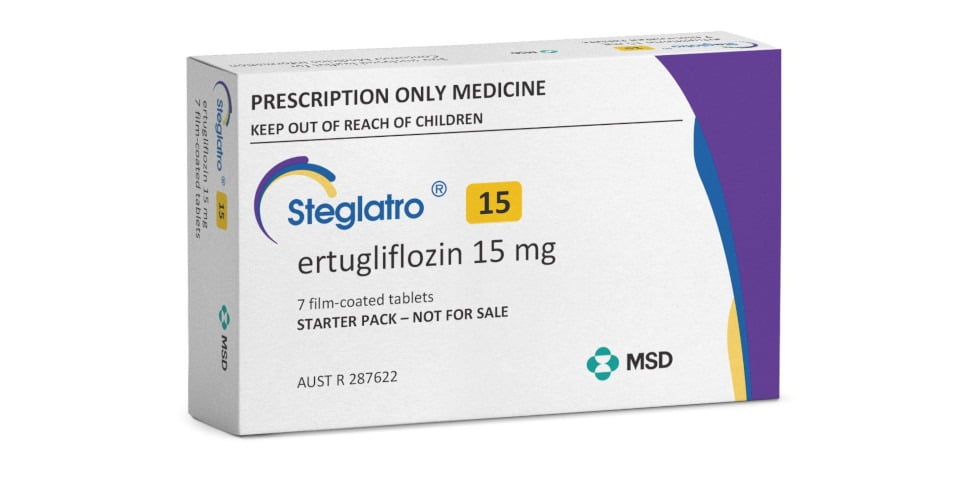 |
| A recent study in the American Journal of Ophthalmology suggests that SGLT2 inhibitors, including ertugliflozin and empagliflozin, may help lower the risk of glaucoma in patients with type 2 diabetes. The research found that these medications were particularly effective in reducing the incidence of open-angle glaucoma and primary angle-closure glaucoma. Photo: Merck. Click image to enlarge. |
Patients diagnosed with type 2 diabetes—of which there are over 462 million worldwide—commonly experience ophthalmic complications, particularly diabetic retinopathy and macular edema. However, glaucoma is a significant comorbidity in adults with diabetes aged 45 and over, with growing evidence to support this association. New anti-diabetic medications, such as glucagon-like peptide-1 (GLP1) receptor agonists, sodium glucose co-transporter 2 (SGLT2) inhibitors and dipeptidyl peptidase 4 (DPP4) inhibitors, have demonstrated some protective effects on ocular complications, including glaucoma, but the literature is sparse. A new study recently published in American Journal of Ophthalmology dove into the impact of SGLT2 inhibitor drugs specifically and discovered patients taking this type of medication had a lower risk of glaucoma, including its subtypes open-angle glaucoma and primary open-angle glaucoma, than those taking either DPP4 inhibitors or GLP1 agonists.
SGLT2 inhibitors, a relatively newer class of anti-hyperglycemic agents, block the reabsorption of glucose in the kidneys, and have been shown to reduce weight, lower blood pressure and improve cardiovascular health. Examples include ertugliflozin, empagliflozin and dapagliflozin, all of which were included in this new population-based study. The risk of incident glaucoma was compared between this drug class and the other two aforementioned ones (DPP4 inhibitors and GLP1 receptor agonists).
For the primary analysis, those in the DPP4 group were chosen as the active comparator because, while similarly used as second-line therapy for type 2 diabetes, this class has no known cardiovascular or renal pleiotropic benefits, noted the authors in the paper.
Researchers identified 2,355,582 eligible patients with type 2 diabetes from 92 healthcare organizations across the United States. Researchers found patients on SGLT2 inhibitors had a lower risk of glaucoma compared to those on DPP4 meds, with an overall hazard ratio of 0.815 and disease subtype ratios of 0.755 for open-angle and 0.592 for primary-angle closure glaucoma. Among all studied drugs in the class, ertugliflozin (Steglatro, Merck) was associated with the lowest risk of glaucoma, followed by empagliflozin, (Jardiance (Lilly), then dapagliflozin (Farxiga (AstraZeneca).
SGLT2 inhibitor use was also found to confer significant protection against low-tension glaucoma and capsular glaucoma with pseudoexfoliation of lens. Therapy also significantly decreased the risk of primary angle-closure glaucoma and neovascular glaucoma. However, their use didn’t show protective effects against pigmentary glaucoma, according to the study.
The authors wrote in AJO, “the significant reduction in risk of incident glaucoma when compared to other antidiabetic medications in our study suggests that the pathophysiologic mechanism by which SGLT2 inhibitors decrease the risk of glaucoma is likely multifactorial, especially when considering its impact on several different glaucoma subtypes.” They suggest it may be best to consider the role of SGLT2 inhibitors in glaucoma risk by subtype, such as for POAG and low-tension glaucoma, in which the benefit is best explained by vascular pathophysiology.
“Meanwhile, choroidal blood vessel pathophysiology may be most implicated in angle closure glaucoma,” they continued. Ongoing investigations have demonstrated that diabetes patients “have a thicker subfoveal choroid and there is increasing evidence that choroidal expansion contributes to angle-closure physiology.” Appropriately controlling this choroidal expansion, such as with SGLT2 inhibitor use, could therefore prevent angle-closure glaucoma, the suggested in their article.
Although they found the results to be encouraging, the authors note that “prospective studies and clinical trials are needed to validate the findings and explore the effect” on the progression of glaucoma.
| Click here for journal source. |
Eng, Kathleen et al. Sodium-glucose cotransporter 2 inhibitors and glaucoma in patients with type 2 diabetes. American Journal of Ophthalmology. November 6, 2024. [Epub ahead of print.] |


